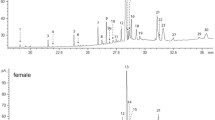Summary
Sexuals ofFormica lugubris fly to mating places, where females attract males by using a sex pheromone. Females collected on the nest surface before departing on a mating flight are much less attractive than those collected on the mating place after the mating flight, suggesting that the mating flight triggers the release of the sex pheromone. Olfactory cues are essential for males to locate females while they patrol. Males probably use visual cues to locate females once they have alighted nearby them. Males are also attracted by aggregations of other males on the ground, probably because one or several females are likely to be close to male aggregations.
Similar content being viewed by others
References
Cherix, D., D. Chautems, D. J. C. Fletcher, W. Fortelius, G. Gris, L. Keller, L. Passera, R. Rosengren, E. L. Vargo and F. Walter, 1991. Alternative reproductive strategies inFormica lugubris Zett.Ethol. Ecol. and Evol. Special Issue 1:61–66.
Hölldobler, B. and S. H. Bartz, 1985. Sociobiology of reproduction in ants. In:Experimental behavioral ecology and sociobiology (B. Hölldobler and M. Lindauer, eds.). Fortschritte der Zoologie, no 31, Sinauer Associates, Sunderland, Mass., 237–257.
Hölldobler, B. and E. O. Wilson, 1990.The ants. Belknap Press. Harvard Univ. Press. Cambridge, Mass., 732 p.
Kannovski, P. B., 1963. The flight activities of Formicine ants.Symposia Genetica et Biologica Italica 12:74–102.
Kannovski, P. B. and R. L. Johnson, 1969. Male patrolling behaviour and sex attraction in ants of the genusFormica.Anim. Behav. 17:425–429.
Leprince, D. J. and A. Francoeur, 1986. Hilltop swarming by ants (Hymenoptera, Formicidae) in southwestern Quebec and interspecific competition at the swarm maker.Ann. Entomol. Soc. Am. 79:867–869.
Marikovski, P. I., 1961. Material on sexual biology of the antFormica rufa L.Ins. Soc. 8:23–30.
Michener, C. D., 1974.The social behavior of bees: a comparative study. Belknap Press. Harvard Univ. Press. Cambridge, Mass., 404 p.
Woyciechowski, M., 1990. Nuptial flights in several ant species and their aerial aggregations (Hymenoptera, Formicidae).Acta Zool. Cracov. 33:555–564.
Ruttner, F., 1962. Drohnensammelplätze.Bienenvater 83:45–47.
Ruttner, F., 1966. The life and flight activity of drones.Bee World 47:93–100.
Talbot, M., 1972. Flights and swarms of the antFormica obscuripes Forel.J. Kansas Ent. Soc.45:254–258.
Walter, F., D. J. C. Fletcher, D. Chautems, D. Cherix, L. Keller, W. Francke, W. Fortelius, R. Rosengren and E. L. Vargo, 1993. Identification of the sex pheromone of an antFormica lugubris (Hymenoptera, Formicidae).Naturwissenschaften 80:30–34.
Zmarlicki, C. and A. Morse, 1963. Drone congregation areas.J. Apic. Res. 2:64–66.
Author information
Authors and Affiliations
Rights and permissions
About this article
Cite this article
Cherix, D., Fletcher, D.J.C., Chautems, D. et al. Attraction of the sexes inFormica lugubris Zett (Hymenoptera: Formicidae). Ins. Soc 40, 319–324 (1993). https://doi.org/10.1007/BF01242368
Received:
Revised:
Accepted:
Issue Date:
DOI: https://doi.org/10.1007/BF01242368




